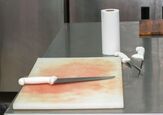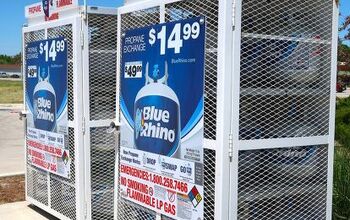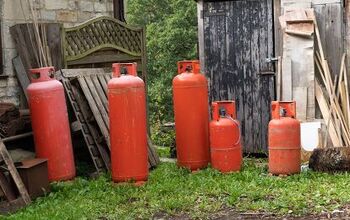Can You Paint A Propane Tank? (Find Out Now!)
Most homeowners will have used a propane system at some point in their lives. Propane is a gas used to heat homes. It’s stored in white metal tanks that are typically placed outdoors in well-ventilated areas.
Unfortunately, these metal white propane tanks don’t exactly blend into the yard. If you have one, you might want to hide it, or at least make it look more attractive. So the question is, can you paint your propane tank to spruce it up?
The answer is yes, you can paint a propane tank. But tanks should always be painted a lighter, reflective color. Whites, off-whites, and certain pastels are approved under the NFPA. It’s important to note that there are certain colors and paint types you should NOT use, including dark colors and paints not designed for metal surfaces.
Do You Need Exterior Home Paint or Stain Services?
Get free, zero-commitment quotes from pro contractors near you.

What Color to Paint Propane Tank
While the freedom to paint your propane tank is nice, you can’t just choose any old color. This is not for the sake of being needlessly strict, but for the safety of your home.
The National Fire Protection Association (NFPA) has set standards for acceptable colors. The requirement is to use a lighter, reflective paint color. State laws also individually govern paint color types. If you’re unsure about your state laws, you should contact your local propane supplier.
The NFPA has determined these colors to be safe to paint on your propane tank:
- Whites
- Off-whites and beiges
- Silver
- Light gray
- Certain pastels (depending on local state laws)
It’s better to be safe than sorry. Feel free to utilize these colors to create unique designs, adding an artistic touch to the tank. The most important thing is to maintain your safety with this flammable gas.
Why Can’t Propane Tanks Have Dark Colored Paint?
By now you know not to paint your propane tank a dark, non-reflective color. But why not? Well, because of the basic laws of thermodynamics at work. Dark colors absorb heat much more than light, reflective colors. This heat absorption causes the gas to expand and leads to a high pressure situation within the tank.
High pressure due to expanding gas runs the risk of opening the safety relief valve. Gas can escape from an open safety relief valve, increasing the chance of explosion. This is part of the reason propane tanks should not be stored indoors, even in places like the garage.
Types of Paint To Use
Not only is the color of the paint important, but the type of paint matters too. Make sure you consider these factors when choosing a paint type:
- Look for rust-inhibiting paints. Paints specifically designed for metal surfaces usually include rust inhibitors that will prevent rust from accumulating on the tank’s surface. This is important to extending the life of your propane tank.
- Look for paints made specifically for propane tanks. Yes, these exist. And you can find them at your local hardware store. They will save you the trouble of selecting the right generic paint that will work on your tank.
- Look for paints you’re most comfortable using. Whether it’s a paint roller or spray paint, select the paint type you’re comfortable applying. It will look the smoothest and most seamless.
Again, don’t forget to use a paint designed for metal surfaces. Diamond Brite, Rust-Oleum, and Van Sickle Propane Tank Paint are all good options. These are designed to be applied to metal and prevent rust.
Related Guide: What Kind Of Paint Do You Use On A Propane Tank?
How to Paint a Propane Tank
So you’ve decided to spice up your propane tank with a fresh coat of paint! Maybe you want to improve the bland white color, or get rid of its rusty, dirty look. Or maybe you want to paint it so it blends in better with the surrounding greenery. Whatever the reason, follow these simple steps!
Step One: Remove Rust With Wire Brush
Before you apply any paint to the tank, you’ll need to make sure the surface is smooth. Propane tanks collect dirt and rust, making the surface uneven. Also, painting over rust will leave the tank vulnerable to even more rust accrual.
To remove dirt and other debris, hose down the propane tank or wipe it with a rag. Use a wire brush to scrape off any patches of rust. If the entire tank is riddled with rust, you might have to replace the tank. Consult with your propane supplier on this matter if you’re unsure what to do.
Step Two: Paint Tank With Primer
At this stage, the surface of your tank should be smoothed out, cleaned, dried, and ready to go. To ensure the longevity of your fresh coat of paint and tank life, apply a primer before the final painting.
To do this, lay out some drop cloths around the tank. Place painter’s tape over any places you don’t want the primer to go. Make sure to place tape over the data tag — it will not be serviced if propane providers can’t read the information.
Then, using a rust-inhibiting primer spray (white or off-white), apply the primer using a steady side-to-side sweeping motion. Let the primer dry as directed. Once fully dry, apply a second layer.
Step Three: Paint Tank With Approved Color
Hopefully you’ve selected the optimal paint type and color for the job. Remember to only use light, reflective colors. Now is your chance to get creative with any tools at your disposal!
What paint applicator are you most comfortable with? Choose between a paint roller or paint spray for coverage of large areas. You can also utilize hand brushes to create smaller details and designs.
First, collect all your tools in one place. These supplies might include:
- A white or off-white rust-inhibiting primer paint
- A white, light gray, silver, or pastel paint designed for metal surfaces
- Drop cloths
- A paint roller and paint tray
- A small brush, stencils, and sponges to create details and designs
Once you’re prepared, go ahead and spray or roll on your base coat. Let it dry for 24 hours, then apply a second coat.
Step Four: Get Creative With Designs
Want to use some artistic creativity? Let the base coat completely dry, then add another layer of interesting designs. The sky’s the limit here.
You can add a light layer of a different color over the primer to give your tank a cool pastel tint. Or use sponges and stencils to create unique paint designs.
Fun ideas include a submarine, a caterpillar, a watermelon, inspirational quotes, and other creative designs.
Do You Need Exterior Home Paint or Stain Services?
Get free, zero-commitment quotes from pro contractors near you.

Related Questions
Can propane tanks explode?
Because propane is a combustible gas, it is possible for propane tanks to explode. But this is not a common occurrence. Propane tanks have built-in safety features, like relief valves, to prevent explosions. Make sure the propane tank is closed when you are not using it to prevent high-pressure explosions.
Can you bury a propane tank?
Yes, you can bury a propane tank underground. Burying a propane tank is a good option for homeowners who have a 500 gallon tank or larger. Propane leaks underground are not dangerous for the soil or water.
More by Jessica Vaillancourt



























